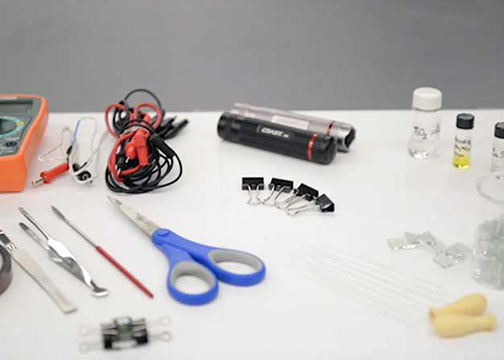Northwestern University scientists, Sameer Patwardhan and Duyen Cao, from the Argonne-Northwestern Solar Energy Research (ANSER) Center have developed a first-of-its-kind solar cell fabrication lab for general chemistry students.
In its first run, the lab was introduced to 208 first-year students who built perovskite solar cells, third generation dye-sensitized solar cells, in a two-hour lab block. The students used standard lab equipment, with the total cost of each cell amounting to a mere 20 cents.
“This was our attempt to bring this emerging technology to undergraduate labs, and make it widely accessible,” says Sameer Patwardhan, a postdoctoral scholar in the ANSER Center, a Northwestern-led Energy Frontier Research Center that works to develop a fundamental understanding of the molecules, materials and methods to create dramatically more efficient technologies.
Perovskite cells have long had the advantage of being low-cost, environmentally friendly, and readily available, a combination that makes them great candidates for broad distribution.
Patwardhan and Cao's inspiration for designing the lab came from a long-standing culture of interdisciplinary collaboration at ANSER, as well as groundbreaking research by ANSER’s nanotechnology expert Robert P.H. Chang and chemist Mercouri Kanatzidis. In 2012, the two researchers improved upon the award-winning Grätzel cell, lauded for its low-cost and environmentally-friendly design. Chang and Kanatzidis extended the Grätzel cell’s relatively short 18-month lifespan– compared to 20 years for conventional silicon technologies—by replacing its leaky liquid center with a solution that dries to form perovskite, a stable solid.
“This discovery was a renaissance in perovskite solar cell technology. Now, more than 100 groups are working in this field worldwide,” says Dick Co, ANSER’s Director of Operations and Outreach.
By participating in the lab, Northwestern undergrads experience that renaissance first hand, in diverse teams.
“It’s a truly interdisciplinary project. At the general chemistry level we have chemists, material scientists and electrical engineering students all working together,” says Patwardhan.
Michaela Davis (WCAS '18), a first year chemistry major was surprised to find that the lab was accessible to her introductory-level class.
“The fact that it’s something a lay person can do – create electricity from sunlight—that’s pretty cool,” she says.
Patwardhan and Cao are working on a redesign of the lab and will implement it in additional courses by the end of the 2014-2015 school year. The students will be tasked with building the second generation of these cells, the best of which will be chosen to build solar panels and drive electronic devices.
“At this stage, we’ve achieved the voltage and current we wanted from the cell,” says Patwardhan. “The next step is to get the cells to power a small LED. With a panel, we can do that.”
In just two trials, Patwardhan and his team will have achieved what they set out to do — create a replicable lab for students around the world, enabling undergraduates to get involved in creating solar cell technologies.
“If we can light an LED, this will be the first experiment where students get to fabricate cells from scratch, from raw materials to a functioning solar panel,” says Patwardhan.
And from there, he says, the possibilities are endless. “I’ll have to explore what little things we can power next.”
The experiment appears in the Journal of Physical Chemistry Letters as a ViewPoint article in January 2015.
Video by Melissa Schenkman, MEDILL



